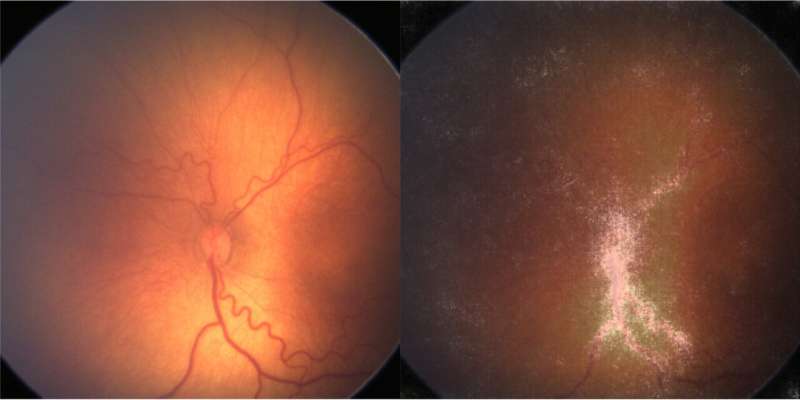This article has been reviewed according to Science X'seditorial processandpolicies.Editorshave highlighted the following attributes while ensuring the content's credibility:
fact-checked
trusted source
proofread
AI breakthrough in detecting leading cause of childhood blindness

The team developed a deep learning AI model that can identify which at-risk infants have ROP that may lead to blindness if left untreated, and they hope their technique could improve access to screening in the many areas with limited neonatal services and few trained ophthalmologists.
The study, by an international team of scientists and clinicians in the UK, Brazil, Egypt and the US, supported by the National Institute for Health and Care Research (NIHR) Biomedical Research Centre at Moorfields Eye Hospital NHS Foundation Trust and UCL Institute of Ophthalmology, is published inThe Lancet Digital Health.
Lead author Dr. Konstantinos Balaskas (Director, Moorfields Ophthalmic Reading Centre & Clinical AI Lab, Moorfields Eye Hospital and Associate Professor, UCL Institute of Ophthalmology) said, "Retinopathy of prematurity is becoming increasingly common as survival rates ofpremature babiesimprove across the globe, and it is now the leading cause of childhood blindness in middle-income countries and in the US."
"As many as 30% of newborns in sub-Saharan Africa have some degree of ROP and, while treatments are now readily available, it can cause blindness if not detected and treated quickly. This is often due to a lack of eye care specialists—but, given it is detectable and treatable, no child should be going blind from ROP."
"As it becomes more common, many areas do not have enough trained ophthalmologists to screen all at-risk children; we hope that our technique to automate diagnostics of ROP will improve access to care in underserved areas and prevent blindness in thousands of newborns worldwide."
ROP is a condition primarily affecting premature babies, whereabnormal blood vesselsgrow in the retina, the thin layer of nerve cells at the back of the eye that converts light into signals the brain can recognize. Theseblood vesselscan leak or bleed, damaging the retina, and possibly leading to retinal detachment. While milder forms of ROP do not require treatment, only monitoring, more acute cases require prompt treatment. An estimated 50,000 children globally are blind because of it.
Symptoms of ROP cannot be seen by thenaked eye, meaning the only way to identify the condition is by monitoring infants at risk with eye exams. Without the proper infrastructure for comprehensive antenatal and postnatal care, the narrow window for screening and treatment could be missed, leading to preventable blindness.
The UCL-Moorfields team have developed adeep learningAI model to screen for ROP, which was trained on a sample of 7,414 images of the eyes of 1,370 newborns who had been admitted to the Homerton Hospital, London, and assessed for ROP by ophthalmologists. The hospital serves an ethnically and socioeconomicallydiverse community, which is important as ROP can vary betweenethnic groups, so the tool was trained to work safely across different ethnic groups ensuring anyone can benefit.
The tool's performance was then assessed on another 200 images and compared to the assessments of senior ophthalmologists.
The researchers further validated their tool by employing it on datasets sourced from the US, Brazil and Egypt.
The AI tool was found to be as effective as senior pediatric ophthalmologists in discriminating normal retinal images from those with ROP that could lead to blindness.
While the tool was optimized for a UK population, the researchers say it is promising that they found it to still be effective on other continents, and they add it could still be further optimized for other environments. The tool has been developed as a code-free deep learning platform, which means it could be optimized in new settings by people without prior coding experience.
First author Dr. Siegfried Wagner (UCL Institute of Ophthalmology and Moorfields Eye Hospital) said, "Our findings justify the continued investigation of AI tools to screen for ROP. We are now further validating our tool in multiple hospitals in the UK and are seeking to learn how people interact with the AI's outputs, to understand how we could incorporate the tool into real world clinical settings."
"We hope that the tool will enable a trained nurse to take images that could be assessed by the AI tool, in order for a referral for treatment to be made without the need for an ophthalmologist to manually review the scans."
"AI tools are particularly useful in ophthalmology, a field which is heavily reliant on the manual interpretation and analysis of scans for detection and monitoring—here we have found further evidence that AI can be a game-changer for the field and open up access to sight-saving treatments."
More information:Siegfried K Wagner et al, Development and international validation of custom-engineered and code-free deep-learning models for detection of plus disease in retinopathy of prematurity: a retrospective study,The Lancet Digital Health(2023).DOI: 10.1016/S2589-7500(23)00050-X



















